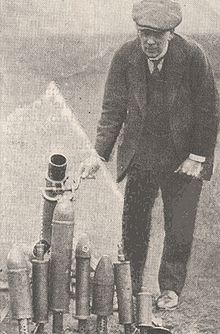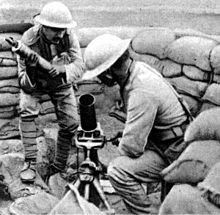Stokes mortar
| 3 inch Stokes mortar | |
|---|---|
 Sir Wilfred Stokes with example of his mortar and bombs. Typical 3-inch bombs used are 2nd and 6th from left | |
| Type | Light mortar |
| Place of origin | United Kingdom |
| Service history | |
| Used by |
|
| Wars | |
| Production history | |
| Designer | Sir Wilfred Stokes KBE |
| Designed | 1915 |
| Specifications | |
| Mass | 104 lbs (47.17 kg) total[3] |
| Crew | 2 |
| Shell | HE 10 lb 11 oz (4.84 kg)[4] |
| Calibre | 3.2 in (81 mm)[5] |
| Action | Trip |
| Elevation | 45°-75°[6] |
| Rate of fire | 25 rpm (maximum)[7] 6-8 rpm (sustained) |
| Effective firing range | 750 yards (686 m) |
| Maximum firing range | 800 yards (731 m)[8] |
| Filling | amatol |
| Filling weight | 2lb 4 oz (1 kg)[9] |
The Stokes mortar was a British trench mortar designed by Sir Wilfred Stokes KBE that was issued to the British and U.S. armies, as well as the Portuguese Expeditionary Corps, during the latter half of the First World War. The 3-inch trench mortar is a smooth-bore, muzzle-loading weapon for high angles of fire. Although it is called a 3-inch mortar, its bore is actually 3.2 inches or 81 mm.[5]
Design[]
Frederick Wilfred Scott Stokes – who later became Sir Wilfred Stokes KBE – designed the mortar in January 1915. The British Army was at the time trying to develop a weapon that would be a match for the Imperial German Army's Minenwerfer mortar, which was in use on the Western Front.
Stokes's design was initially rejected in June 1915 because it was unable to use existing stocks of British mortar ammunition, and it took the intervention of David Lloyd George (at that time Minister of Munitions) and Lieutenant-Colonel of the (who reported to Lloyd George) to expedite manufacture of the Stokes mortar.
The Stokes mortar was a simple weapon, consisting of a smoothbore metal tube fixed to a base plate (to absorb recoil) with a lightweight bipod mount. When a mortar bomb was dropped into the tube, an impact sensitive primer in the base of the bomb would make contact with a firing pin at the base of the tube, and ignite the propellant charge in the base, launching the bomb towards the target. The warhead itself was detonated by an impact fuse on reaching the target.
The barrel is a seamless drawn-steel tube necked down at the breech or base end. To the breech end is fitted a base cap, within which is secured a firing pin protruding into the barrel. The caps at each end of the bomb cylinder were 81 mm diameter. The bomb was fitted with a modified hand grenade fuze on the front, with a perforated tube containing a propellant charge and an impact-sensitive cap at the rear.
Range was determined by the amount of propellant charge used and the angle of the barrel. A basic propellant cartridge was used for all firing, and covered short ranges. Up to four additional "rings" of propellant were used for incrementally greater ranges. The four rings were supplied with the cartridge and gunners discarded the rings that were not needed.
One potential problem was the recoil, which was "exceptionally severe, because the barrel is only about 3 times the weight of the projectile, instead of about one hundred times the weight as in artillery. Unless the legs are properly set up they are liable to injury".[10]
A modified version of the mortar, which fired a modern fin-stabilised streamlined projectile and had a booster charge for longer range, was developed after World War I;[11] this was in effect a new weapon.
History[]
The mortar was in no sense a new weapon, although it had fallen out of general usage since the Napoleonic era. In fact, while the British and French worked on developing new mortars, they resorted to issuing century-old mortars for use in action.
The Stokes mortar remained in service into the Second World War, when it was superseded by the Ordnance ML 3 inch mortar, and some remained in use by New Zealand forces until after the Second World War.
As well as receiving a knighthood[12] for inventing the modern mortar, Stokes was given several forms of monetary reward by the Ministry of Munitions for his invention.[citation needed]
The French developed an improved version of the Stokes mortar as the Brandt Mle 27, further refined as the Brandt Mle 31; this design was widely copied with and without license.[13][14] Despite their indigenous production, out of 8,000 81 mm mortars in service with the French in 1939, 2,000 were of the original Mk. I build purchased from Great Britain.[15]
Combat use[]

In World War I, the Stokes mortar could fire as many as 25 bombs per minute and had a maximum range of 800 yards (732 m) firing the original cylindrical un-stabilised projectile. British Empire units had 1,636 Stokes mortars in service on the Western Front at the Armistice.[16] By World War II, it could fire as many as 30 bombs per minute and had a range of over 2,500 yd (2,286 m) with some shell types.[5] A 4-inch (102 mm) version was used to fire smoke, poison gas, and thermite (incendiary) rounds but this should be considered a separate weapon from the standard "3-inch" version — with an actual bore of 3.2 inches (81 mm) — firing high explosive rounds described in this article. The Stokes mortar was used in the Banana Wars and helped American forces defeat Sandinista rebels during the Second Battle of Las Cruces on 1 January 1928.[17] The Paraguayan Army made extensive use of the Stokes mortar during the Chaco War, especially as a siege weapon in the Battle of Boquerón in September 1932.[1][2] Stokes mortars were widely used by the Republican Army during the Spanish Civil War. In September 1936, 44,000 Stokes rounds arrived in Spain.[18]
About 700 Stokes mortars were acquired by Poland between 1923 and 1926.
Image gallery[]
High explosive bomb 
No. 145 percussion fuze 
Men of the KOYLI fusing Stokes shells near Wieltje, 1 October 1917
See also[]
- Ordnance ML 3 inch mortar : British 1930s successor
Weapons of comparable role, performance and era[]
- 7.58 cm Minenwerfer : approximate German equivalent
Surviving examples[]
- Australian War Memorial, Canberra
- An example with bombs is displayed at l'hotel de ville d'Arras, France.
Bernard Plumier : Link to his web page which has details and photograph Direct link to photograph
See also[]
Notes and references[]
- ^ Jump up to: a b c Mortero Stokes Brandt de 81mm- El mortero del Chaco (in Spanish)
- ^ Jump up to: a b c Boselli Cantero, Cristina and Casabianca, Angel-Francois (2000). Una guerra desconocida: la campaña del Chaco Boreal, 1932–1935. Volumes 4 and 5. Lector, p. 176. ISBN 99925-51-91-7 (in Spanish)
- ^ "Appendix D. Details of Trench Mortars" in "Field Artillery Notes No. 7". Mortar=48 lb; Elevating Stand=28 lb; Base Plate=28 lb; Total Weight for Transport = 104 lbs
- ^ "Appendix E. Details of Ammunition" in "Field Artillery Notes No. 7". This figure is for the unstabilised cylindrical bomb used in World War I.
- ^ Jump up to: a b c War Dept. Technical Manual TM9-2005, Volume 3, Ordnance Materiel - General, Page 17, December 1942
- ^ Range Table For 3-Inch Stokes Mortar 1917, B: "45° gave maximum range with any particular propellant amount e.g. 420 yards with 1 ring. 75° gave the most vertical descent for the shell and the shortest range with any particular propellant amount e.g. 197 yards with 1 ring."
- ^ "Appendix D. Details of Trench Mortars" in "Field Artillery Notes No. 7"
- ^ Range Table For 3-Inch Stokes Mortar 1917, A: "At 45° using 4 Rings of propellant. This figure is for the unstabilised cylindrical bomb used in World War I."
- ^ "Appendix E. Details of Ammunition" in "Field Artillery Notes No. 7"
- ^ Stokes's Trench Howitzer 3" Mark I, page 15
- ^ Ruffell.
- ^ "No. 30250". The London Gazette (Supplement). 24 August 1917. p. 8795.
- ^ Chris Bishop (2002). The Encyclopedia of Weapons of World War II. Sterling Publishing Company. p. 202. ISBN 978-1-58663-762-0.
- ^ "Brandt mle 27 (Mortier Brandt de 81mm modele 27) Infantry Mortar - France".
- ^ John Norris (2002). Infantry Mortars of World War II. Osprey Publishing. pp. 42–43. ISBN 978-1-84176-414-6.
- ^ Farndale 1986, p. 342.
- ^ "The Sandino Rebellion, 1927-1934". www.sandinorebellion.com.
- ^ Howson, G. (2000). Armas para España: la historia no contada de la Guerra Civil Española. Península, Madrid, p. 394
Bibliography[]
- "Range Table For 3-Inch Stokes Mortar". United Kingdom War Office. September 1917. Cite journal requires
|journal=(help) - "Stokes' trench howitzer, 3", mark I". US Army War College, January 1918. Made available online by Combined Arms Research Library
- Field Artillery Notes No. 7. US Army War College August 1917. Provided online by Combined Arms Research Library
- Canfield, Bruce N. (2000). "The Three Inch Stokes Mortar". U.S. Infantry Weapons of the First World War. Andrew Mowbray Pub. ISBN 978-0917218903.
- Farndale, M. (1986). Western Front 1914–18. History of the Royal Regiment of Artillery. London: Royal Artillery Institution. ISBN 978-1-870114-00-4.
- Ruffell, W. L. "The Stokes Mortar". The Mortar. Archived from the original on 2015-01-14.
External links[]
| Wikimedia Commons has media related to 3 inch Stokes Mortar. |
- "Handbook of the M.L. Stokes 3-Inch Trench Mortar Equipments. 1919." Published by His Majesty's Stationery Office, London, 1920.
- "Basic Field Manual. Volume III, Basic Weapons. Part Four, Howitzer Company. 3-inch Trench Mortar". United States War Department, 1932. Made available online by Combined Arms Research Library
- Infantry mortars
- World War I British infantry weapons
- World War I mortars of the United Kingdom
- World War I infantry weapons of Australia
- World War II infantry weapons of Australia
- 81 mm artillery
- Weapons of the Philippine Army

